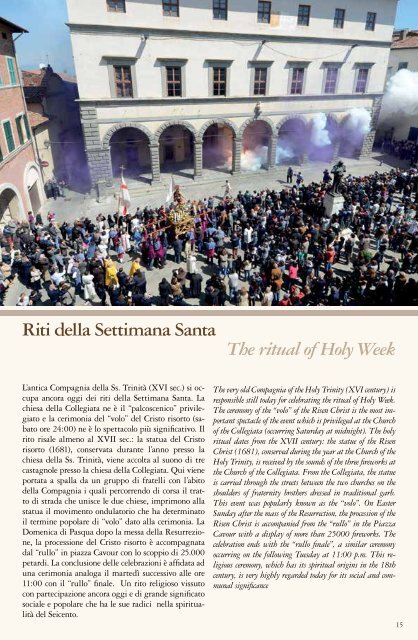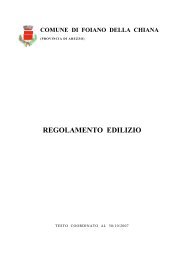Guida del turista - Comune di Foiano della Chiana
Guida del turista - Comune di Foiano della Chiana
Guida del turista - Comune di Foiano della Chiana
Create successful ePaper yourself
Turn your PDF publications into a flip-book with our unique Google optimized e-Paper software.
Riti <strong>del</strong>la Settimana Santa The ritual of Holy Week<br />
L’antica Compagnia <strong>del</strong>la Ss. Trinità (XVI sec.) si occupa<br />
ancora oggi dei riti <strong>del</strong>la Settimana Santa. La<br />
chiesa <strong>del</strong>la Collegiata ne è il “palcoscenico” privilegiato<br />
e la cerimonia <strong>del</strong> “volo” <strong>del</strong> Cristo risorto (sabato<br />
ore 24:00) ne è lo spettacolo più significativo. Il<br />
rito risale almeno al XVII sec.: la statua <strong>del</strong> Cristo<br />
risorto (1681), conservata durante l’anno presso la<br />
chiesa <strong>del</strong>la Ss. Trinità, viene accolta al suono <strong>di</strong> tre<br />
castagnole presso la chiesa <strong>del</strong>la Collegiata. Qui viene<br />
portata a spalla da un gruppo <strong>di</strong> fratelli con l’abito<br />
<strong>del</strong>la Compagnia i quali percorrendo <strong>di</strong> corsa il tratto<br />
<strong>di</strong> strada che unisce le due chiese, imprimono alla<br />
statua il movimento ondulatorio che ha determinato<br />
il termine popolare <strong>di</strong> “volo” dato alla cerimonia. La<br />
Domenica <strong>di</strong> Pasqua dopo la messa <strong>del</strong>la Resurrezione,<br />
la processione <strong>del</strong> Cristo risorto è accompagnata<br />
dal “rullo” in piazza Cavour con lo scoppio <strong>di</strong> 25.000<br />
petar<strong>di</strong>. La conclusione <strong>del</strong>le celebrazioni è affidata ad<br />
una cerimonia analoga il martedì successivo alle ore<br />
11:00 con il “rullo” finale. Un rito religioso vissuto<br />
con partecipazione ancora oggi e <strong>di</strong> grande significato<br />
sociale e popolare che ha le sue ra<strong>di</strong>ci nella spiritualità<br />
<strong>del</strong> Seicento.<br />
The very old Compagnia of the Holy Trinity (XVI century) is<br />
responsible still today for celebrating the ritual of Holy Week.<br />
The ceremony of the “volo” of the Risen Christ is the most important<br />
spectacle of the event which is privileged at the Church<br />
of the Collegiata (occurring Saturday at midnight). The holy<br />
ritual dates from the XVII century: the statue of the Risen<br />
Christ (1681), conserved during the year at the Church of the<br />
Holy Trinity, is received by the sounds of the three fireworks at<br />
the Church of the Collegiata. From the Collegiata, the statue<br />
is carried through the streets between the two churches on the<br />
shoulders of fraternity brothers dressed in tra<strong>di</strong>tional garb.<br />
This event was popularly known as the “volo”. On Easter<br />
Sunday after the mass of the Resurrection, the procession of the<br />
Risen Christ is accompanied from the “rullo” in the Piazza<br />
Cavour with a <strong>di</strong>splay of more than 25000 fireworks. The<br />
celebration ends with the “rullo finale”, a similar ceremony<br />
occurring on the following Tuesday at 11:00 p.m. This religious<br />
ceremony, which has its spiritual origins in the 18th<br />
century, is very highly regarded today for its social and communal<br />
significance<br />
15




